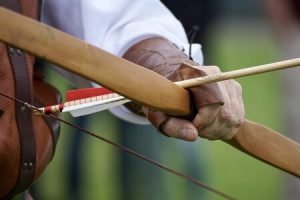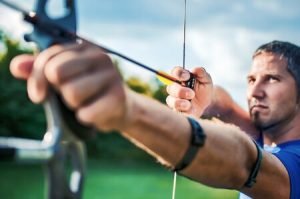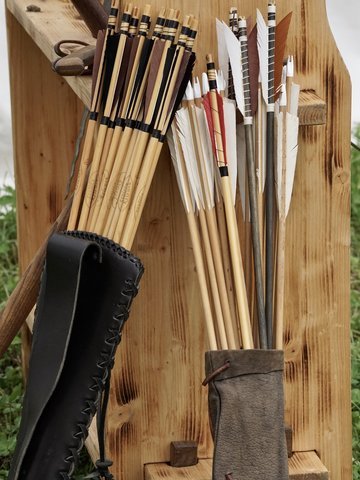
There are a lot of great little gadgets and tools available for archery, from GroPro cameras and handmade leather arm guards to fishing reels that you can fit to your bow for bowfishing.
You’re truly limited only by your imagination, and you certainly don’t need to stress about the cost because to kick off, you just need the bare necessities.
Following are our suggestions of what should be on your archery equipment list to get your heart pumping.
What Kind of Bow Should I Get?
Clearly… the most important piece of gear in your archery arsenal is your bow.
Sorry, no prize for guessing that!!
The type of bow you choose depends on what style of archery you want to try. A recurve bow is the most popular style for beginners, especially a takedown recurve.
This type of bow can easily be broken down for storage or travel. The removable parts also make it easy to clean and maintain. If a part breaks, instead of replacing the whole bow you can just fix the necessary section. After you’ve selected your bow, you’re ready to work on the rest of your archery equipment list.
Your Arrows

As a beginner archer, you should go with arrows that are durable yet affordable. You can always invest in more expensive options later once you get used to shooting.
The arrows you choose depend on the type of bow you buy as well as your personal preferences. Arrows fletched with feathers are typically best for recurve bows while arrows fletched with rubber or plastic vanes are better for compound bows.
There are also several materials to choose from such as wood, aluminum, and carbon.
Aluminum arrows are a good starter option because they’re sturdy but less expensive than the carbon arrows.
Get Yourself a Bow Stringer
A bow stringer helps you safely and easily string your bow whenever you get ready to shoot. You shouldn’t leave your bow strung when it’s not in use, so you’ll regularly be removing the string from your bow. A bow stringer is a simple gadget that helps take the tension off your bow while you’re putting on or taking off the string.
Nocking Points
Nocking points help with shot consistency. They’re typically little metal rings that are fixed to your bowstring and they help you shoot from the same position on the string every shot. This is also a good way to ensure you’re not shooting from too low on your bow string.
As a beginner, you should have someone help set up your nocking points so you know they’re in the correct location. Either ask an experienced friend or check with your instructor during your first lesson.
How About an Uber Cool Leather Armguard

It really hurts when the bow string strikes your arm, so an armguard is a worthwhile piece of protective gear to have in your bag.
A leather armguard, in particular, is of great benefit for a number of important reasons…
- First, high-quality leather is incredibly durable so the product will last you a long time.
- Second, leather is flexible and soft so wearing the armguard while you’re shooting will be comfortable.
- Finally, premium leather looks really good, so you’ll love the beauty of this accessory.
Shooting Glove
A Quiver to Keep Your Arrows Safe
Choosing an archery quiver doesn’t need to be difficult, as long as you know what you’re looking for.
The sport of archery is becoming more and more popular, and there are a multitude of options to choose from when it comes to your equipment.
When you’re out on the archery range you need a way to hold your arrows , which is where an arrow quiver comes in handy.
There is currently a wide range of quivers available on the market and if you’re just starting out, it may be best to go with something small and compact.
A heavy duty, large size quiver may seem more appealing at first glance, but it will decrease portability when compared to a smaller one.
Most people typically envision a back quiver thanks to famous media depictions of archers, but hip quivers are actually the most popular option for bowmen today. A hip quiver is comfortable and makes it much easier to reach your arrows than with a back quiver.
It doesn’t matter if you choose a quiver that looks cool or one that is functional, as long as you make an informed decision.
Archery Bow Sights
A bow sight is used to help you aim during target practice. As a beginner, this piece of equipment can help you learn where to look and how to properly aim from the get go.
There are two types of sights to consider: a single-pin sight and multi-pin sight. A single-pin sight has one pin, which you line up with the target before shooting. A multi-pin sight has several pins that each correspond to a different shooting distance. You line up your shot depending on how far you are from the target.
It doesn’t matter if you choose a quiver that looks cool or one that is functional, as long as you make an informed decision.
Archery Skills and Techniques
All archers generally stick to a set of guidelines too maintain their archery skills and techniques and, although their routines may differ slightly from each other, they all share the same goal and that is to help them retain their level of accuracy.
The following guidelines are not applicable to every variation of archery however they will provide some idea of the procedures.
Your Grip on The Bow

Make it a custom that you check your grip before releasing,
Your bow just needs to be lightly supported by you as you prepare and think about your shot procedure.
Stand with your feet lined up with the centre of the target, so if you’re right handed your left foot is to be in front. Your feet need to be spaced about the same distance between your shoulders and your toes need to be at right angles to the target.
That is, if you’re a right hander the left side of your left foot should be squarely facing the target.
Loading the Arrow
Before we start on that…
- The ‘Nock’ is the slot cut into the end of the arrow that the bow string slips over.
- The ‘Fletching’ is the 3 flights at the tail end of the bow (the Nock end) that keep the arrow flying straight.
Next, locate the arrow rest on the bow and place the arrow. Pull the arrow backwards so the nock straddles the bow string.
Note on the arrow that one of the 3 fletches is generally a different color than the other two. The odd one should be facing out so it doesn’t brush against the bow as its released.
Holding the Bow String

Your ring finger and your middle finger should be positioned under the arrow while your pointer finger should be above the arrow.
The string needs to always be gripped loosely.
The position of your fingers on the string is an important factor in archery and, if not done correctly, your accuracy will falter.
To maintain greater accuracy it’s a good idea to double check your finger placement before releasing.
Sounds easy but learners can become overwhelmed with what they need to do and may struggle with this so if you’re in this position just take your time, don’t rush it.
Drawing the Bow
With your arm raised and your bow arm (not the one drawing the string) pointed at the target, draw the string towards your anchor point. The position of the anchor point is not fixed and can vary based on whether or not you’re using a bow sight.
Anchor points may be your chin, your cheek or even the corner of your mouth.
Aiming Your Bow

Shooting with sights is most favored however many archers still prefer instinctive shooting because it presents a greater challenge
To aim, draw your string fully back to the anchor point, seek the target and focus using your preferred eye. Move the bow into target position and release the arrow.
The Release
Let go of the string by relaxing your fingers. Don’t jerk or move the bow after you have released the arrow. Stay in the stance until the arrow hits the target as to not move while the arrow is being released.
Archery is quite deceptive because it looks relatively simple but in reality, it’s not.
Step 1
However, the first step in the release process is actually not complicated at all but the second step is a different story.
Once you’re OK to shoot this first step is simply a matter of letting go of the bow string and following your arrow to the target, hopefully the bulls eye.
The power of your bow will do all the hard work for you.
Step 2
The second step of the release is basically a natural extension of steep 1, with a difference.
After you letting go of the string the following actions need to take place.
- Your release hand should slowly pull back a little.
- Your chest should expand and enlarge slightly.
- The muscles in your back need to contract a little so that your shoulders are pulled closer together.
The hand coming back towards you face after releasing is referred to as a dynamic release.
There’s another style whereby your hand doesn’t ‘come back’ after release which is referred to as a static release. This second option is best left to competent archers due to its level of difficulty, best option for beginners by far is the dynamic release.
The Best Time to Buy Archery Equipment
Just before we get into the best time to buy archery equipment, here’s some information about the value of owning your bow against renting one.
If you’re fortunate to own your bow you can enjoy the benefits that come with not having to rent a bow, and some of these advantages can make a worthwhile difference.
When you have purchased a bow, believe it or not, your shooting skills will get better simply due to the fact that practicing becomes far less inconvenient.
But what is much more valuable is the pros in the shop where you buy it will be morally responsible to assist in choosing the right bow for you in terms of size, weight and draw weight.
In other words, the bow will be fitted to you.
They will also offer some valuable archery safety tips that may very well keep you alive!
A bow that has been customized to your personal preferences will ensure that your archery will be far more enjoyable.
If you’ve been researching bows and you have a particular model in mind, do your best to find out when the company that makes that bow is releasing a new model to replace the one you’re after and ‘keep your eyes peeled’ for end-of-model sales.
You’ll usually snag a great bargain using this method.
During off-season is also a terrific time to do some bargain watching, archery equipment sales drop by more than half during this quiet period and retailers will be extremely keen to do a deal.
The majority of archery equipment manufacturers showcase their latest gear in January at the Archery Trade Association show and literally thousands of archers attend the show to purchase the latest models. It’s at this time that the models for the previous year are sold off at greatly reduced prices.
Conclusion
Be sure to follow my tips for buying a bow at the best price and keep an eye out for the special deals. Once you fulfil your archery equipment list you’ll be ready to start your amazing journey into the awesome world of archery.
Related Posts
- Revealed: The Best Archery Bow for Your Money?
Below are the 4 main types of bows and the best archery bow for your money…
- The Secret's Out: How to Get Started With Archery?
If you’re wanting to know how to get started with archery you'll require the patience…

